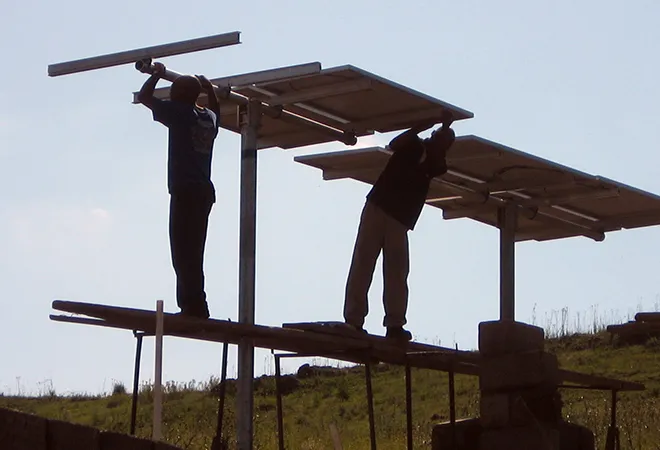-
CENTRES
Progammes & Centres
Location
The many success stories of Indian LOC funded projects, which has been welcomed positively by Africa, indicates the point that African countries have over the years remained the primary beneficiary of Indian development assistance through LOCs.

Africa’s centrality in India’s foreign policy initiatives has consolidated over the years, primarily driven by economic interests and the quest for international recognition. Indian efforts to contribute developmentally to Africa have lately come to the forefront of its policy engagement with these countries with a promise to become more central in the years to come.
India has a long-standing development cooperation policy. Four main techniques embody India’s development cooperation, namely; capacity building and training, lines of credit (LOC), grant assistance, and bilateral trade and investments. The Government of India has been providing LOC to African countries since 1964 under Indian Technical and Economic Cooperation (ITEC) and Special Commonwealth Assistance for Africa Programme (SCAAP).
Four main techniques embody India’s development cooperation, namely; capacity building and training, lines of credit (LOC), grant assistance, and bilateral trade and investments.
Lines of Credit (LOC) is a financial mechanism extended by the Export-Import (EXIM) Bank of India. In order to promote bilateral, regional and commercial relations, the EXIM Bank extends LOCs to support export of eligible goods on deferred payment terms. Under the Indian Development Initiative (IDI) formulated in 2003, the Government extends LOCs to share India’s development experience through capacity building, trade, and infrastructure development. The IDI is presently known as Indian Development and Economic Assistance Scheme (IDEAS). The guidelines for IDEAS was revised by the Narendra Modi government in 2015, and is now applicable till 2019-2020.
Under the new guidelines, countries have been classified into three categories; Low and Lower Middle Income (L& LMI) countries with a minimum binding concessional requirement, Low and Lower Middle Income (L& LMI) with no minimum binding concessional requirement, and other developing countries. The revised terms of credit is shown below.
| Country classification | L& LMI countries with minimum binding concessional requirement | L& LMI countries with no minimum binding concessional requirement | Other developing countries |
| Rate of interest | 1.5 % | 1.75% | Libor+1.5 % |
| Maturity | 25 years | 20 years | 15 years |
| Moratorium | 5 years | 5 years | 5 years |
| Grant element* | 37.48 % | 31.37 % | 24.31% |
Source: Ministry of External Affairs, Government of India
* Grant element is calculated as per IMF prescribed formula
The African continent over the years has remained a primary destination for the government’s Lines of Credit (LOCs). It is important to note that the extension of LOC by India to African countries is different from that of other international financial organisations such as IMF and World Bank. The funding of these global institutions is directly passed over to the respective countries treasury, thereby opening lot of scope for theft and mishandling of funds.
Indian LOC on other hand is demand driven. The projects are identified primarily by African countries. The process for approving LOCs is simple. First, the host-country requests for an LOC, along with a pre-feasibility report and an estimated cost of the project. Then, the Indian Mission in the partner country forwards the proposal along with its recommendations to the Ministry of External Affairs (MEA) in New Delhi. The MEA then recommends the proposal to the Foreign Trade Division in the Department of Economic Affairs, Ministry of Finance for appraisal. After examining and accepting the proposal, the Ministry of Finance conveys its approval of the LOC and terms (interest rate, credit period) to the Export-Import (EXIM) Bank of India. The EXIM Bank then conveys the terms and sends the draft LOC agreement to the borrower government/institution which then can accept the terms and draft of LOC and suggest changes to EXIM Bank. After the draft of the agreement is finalised, the LOC agreement is signed between EXIM Bank and borrower country/institution.
It is important to note that the extension of LOC by India to African countries is different from that of other international financial organisations such as IMF and World Bank. The funding of these global institutions is directly passed over to the respective countries treasury, thereby opening lot of scope for theft and mishandling of funds.
This is the direct difference between India’s economic model towards African development and US/European Union policies.
Over the years, there has been a sharp increase in LOCs committed to African countries. In 2004, LOCs to Africa were valued at $304 million while in 2011 LOCs to Africa were valued at $4.3 billion. In 2012, 17 LOCs were made operational and 12 of these LOCs were directed to African countries.
Under the first India-Africa Forum Summit (IAFS-I), India announced a grant of $500 million (INR 2,700 crores) to assist capacity building in Africa through setting up of specialised institutions, extending scholarships and training programs, and implementing the Pan African e-Network Project (PAeNP). Under IAFS-II, India announced a grant of $700 million (INR 3,300 crores). Under IAFS-III, India provided an additional $10 billion in concessional credit over the next five years, i.e. till 2020, and a grant assistance of $600 million.
Speaking at the first annual meeting of African Development Bank (AfDB) in May 2017, Indian PM Narendra Modi said that Govt. of India has extended total 152 LOCs worth close to $8 billion in 44 African countries.
Recently, following the establishment of International Solar Alliance (ISA) on 11 March 2018, the nature of Indian LOCs to Africa has undergone a visible shift. India’s offer of extending LOCs worth $1 billion to ensure the implementation of 23 solar energy projects ning across 13 African countries is in line with the MEA’s decision to earmark 15-20% out of the total $10 billion LOC, extended under IAFS-III, for undertaking solar energy projects in Africa.
This focus on investing on renewable energy and sustainable development projects is a shift from its earlier focus on traditional areas of cooperation between India and Africa such as IT, science and technology, agriculture, pharmaceuticals, etc.
Following the establishment of International Solar Alliance (ISA) on 11 March 2018, the nature of Indian LOCs to Africa has undergone a visible shift. India’s offer of extending LOCs worth $1 billion to ensure the implementation of 23 solar energy projects ning across 13 African countries is in line with the MEA’s decision to earmark 15-20% out of the total $10 billion LOC, extended under IAFS-III, for undertaking solar energy projects in Africa.
At the ISA founding conference on March, 2018, India announced a total of 27 solar projects ning across 15 countries. The total value of the projects is estimated to be around $1,392.48 million. Among them, 13 countries are from the African continent. This shows India’s willingness to partner developmentally in Africa’s journey. Indian projects in Africa is people-centric and is identified only after due consultations with host governments.
To this end, a Project Preparation Facility (PPF) has been set up to identify the viability of projects which are eligible for concessional financing under Lines of Credit. The 13 solar projects under GOI LOC are at various stages of implementation and progress.
Some of the other African countries where solar projects have been proposed are; Benin, Burkina Faso, Chad, Democratic Republic of Congo, Ghana, guinea, Mali, Rwanda, Seychelles, Tanzania and Togo. The projects will be monitored closely by the MEA to ensure effective implementation, strict adherence to timelines, and prevention of misappropriation and theft of funds.
The countries involved in the projects signifies a shift in the destinations of Indian LOCs in terms of geographic region. While India has focused traditionally in Eastern Africa, the selection of countries for these solar energy projects indicates India’s growing desire to focus on the resource-rich Francophone Western African countries. The many success stories of Indian LOC funded projects, which has been welcomed positively by Africa, indicates the point that African countries have over the years remained the primary beneficiary of Indian development assistance through LOCs.
Solar projects under implementation under GOI LOCs:
| S. no. | Country | Goods to be covered | Status |
|
1. 2. 3. 4. 5. 6. 7. 8. 9. 10. 11. 12. 13. |
Mauritius Mozambique Niger Niger Niger Niger (through EBID LOC) Nigeria Sierra Leone (through EBID LOC) Sudan Sudan Sudan Suriname Senegal |
Design, supply, installation, testing and commission of a 8 MW ac Solar PV farm at Henrietta Turnkey project for setting up a Solar Photo Voltaic Modules Manufacturing Plant of 5 MWp/year capacity Construction of Solar Thermal Plant of 5MW in Malabaza and electrification of 30 villages Design, engineering, procurement, supply, erection, testing, commission of Electrification works for 50 villages by Crystalline Solar Photovoltaic system Design, engineering, procurement, supply, erection, testing and commissioning of Solar photo voltaic 7 MW powerplant in Malbaza Solar electrification of 50 villages Solar Mini Grid electrification and solar Street Lightning project in the Kaduna state Supply and installation of Solar Street Lightning Solar photovoltaic module manufacturing plant Supply of equipment for Solar Electrification Solar Photovoltaic Modules HF Communication equipment, Solar lanterns Supply, transportation and installation of equipment for electrical network in different regions |
Under Implementation Completed Under Implementation Under Implementation Under Implementation Under Implementation Under Implementation Completed Completed Completed Completed Completed Under Implementation |
Source: Ministry of External Affairs, Government of India
It is also widely known that China has a long history of funding energy projects in Africa. As India is making inroads in the African continent by investing in energy projects, another avenue of India-Africa cooperation in trade and investments has opened. However, Indian investments in Africa need to expand and diversify towards ‘broad’ range and not remain restricted to traditional sectors of investments.
Such investments presents a win-win situation for both India and Africa. It will bring technology to African markets which is “appropriate, affordable and adaptable”, and will help India to achieve its renewable energy targets, sustainable development goals (SDGs) and will further India’s Green Good Deeds campaign.
The views expressed above belong to the author(s). ORF research and analyses now available on Telegram! Click here to access our curated content — blogs, longforms and interviews.

Abhishek Mishra is an Associate Fellow with the Manohar Parrikar Institute for Defence Studies and Analysis (MP-IDSA). His research focuses on India and China’s engagement ...
Read More +